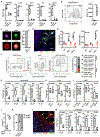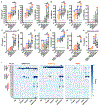An adjuvant strategy enabled by modulation of the physical properties of microbial ligands expands antigen immunogenicity
- PMID: 35148840
- PMCID: PMC8857056
- DOI: 10.1016/j.cell.2022.01.009
An adjuvant strategy enabled by modulation of the physical properties of microbial ligands expands antigen immunogenicity
Abstract
Activation of the innate immune system via pattern recognition receptors (PRRs) is key to generate lasting adaptive immunity. PRRs detect unique chemical patterns associated with invading microorganisms, but whether and how the physical properties of PRR ligands influence the development of the immune response remains unknown. Through the study of fungal mannans, we show that the physical form of PRR ligands dictates the immune response. Soluble mannans are immunosilent in the periphery but elicit a potent pro-inflammatory response in the draining lymph node (dLN). By modulating the physical form of mannans, we developed a formulation that targets both the periphery and the dLN. When combined with viral glycoprotein antigens, this mannan formulation broadens epitope recognition, elicits potent antigen-specific neutralizing antibodies, and confers protection against viral infections of the lung. Thus, the physical properties of microbial ligands determine the outcome of the immune response and can be harnessed for vaccine development.
Keywords: Dectin; PAMP; PRR; SARS-CoV-2; coronavirus; inflammation; influenza A virus; innate immunity; interferon; pathogen-associated molecular pattern; pattern recognition receptor; viral glycoprotein.
Copyright © 2022 Elsevier Inc. All rights reserved.
Conflict of interest statement
Declaration of interests F.B., E.N., T.R.O., I.Z., D.J.D., and O.L. are named inventors on invention disclosures and patents involving vaccine adjuvants. S.J.E. is a founder of TSCAN Therapeutics, ImmuneID, MAZE Therapeutics, and Mirimus. S.J.E. serves on the scientific advisory board of Homology Medicines, TSCAN Therapeutics, MAZE Therapetics, and XChem, and is an advisor for MPM, none of which impact this work. S.J.E. is an inventor on a patent application issued to the Brigham and Women’s Hospital (US20160320406A) that covers the use of the VirScan library to identify pathogen antibodies in blood. The other authors declare no commercial or financial conflict of interest.
Figures







Comment in
-
Fungal sugars boost vaccine protection.Cell. 2022 Feb 17;185(4):579-581. doi: 10.1016/j.cell.2022.01.020. Epub 2022 Feb 10. Cell. 2022. PMID: 35148839
References
-
- Acton SE, and Reis e Sousa C (2016). Dendritic cells in remodeling of lymph nodes during immune responses. Immunol Rev 271, 221–229. - PubMed
-
- Bachmann MF, and Jennings GT (2010). Vaccine delivery: a matter of size, geometry, kinetics and molecular patterns. Nat Rev Immunol 10, 787–796. - PubMed
-
- Banchereau J, and Steinman RM (1998). Dendritic cells and the control of immunity. Nature 392, 245–252. - PubMed
Publication types
MeSH terms
Substances
Grants and funding
- R21 AI159877/AI/NIAID NIH HHS/United States
- R21 AI153480/AI/NIAID NIH HHS/United States
- R01 GM083016/GM/NIGMS NIH HHS/United States
- R01 AI121066/AI/NIAID NIH HHS/United States
- R01 AI148166/AI/NIAID NIH HHS/United States
- 75N93020C00038/AI/NIAID NIH HHS/United States
- R01 DK115217/DK/NIDDK NIH HHS/United States
- R01 AI165505/AI/NIAID NIH HHS/United States
- R21 AI137932/AI/NIAID NIH HHS/United States
- C06 RR030651/RR/NCRR NIH HHS/United States
- 75N93019C00044/AI/NIAID NIH HHS/United States
- R01 GM119197/GM/NIGMS NIH HHS/United States
LinkOut - more resources
Full Text Sources
Molecular Biology Databases
Research Materials
Miscellaneous

